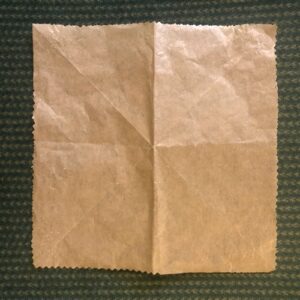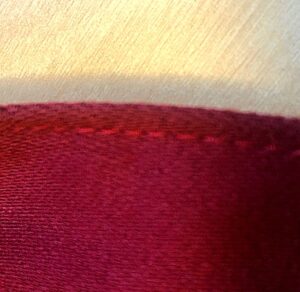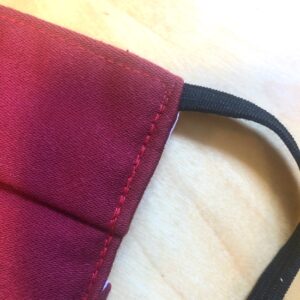 Quite a number of people have asked my about how I made the fabric masks for our family. In late April, I dug out my trusty Singer sewing machine and joined a community sewing project run by my local council here in France.
Quite a number of people have asked my about how I made the fabric masks for our family. In late April, I dug out my trusty Singer sewing machine and joined a community sewing project run by my local council here in France.
After producing 100 masks for them from pre-cut materials to Lille University Hospital approved pattern, I reckoned I had learnt a new skill. So I made family ones from my materials box. I have a full suitcase of offcuts. 😉
Anyway, here are some guidelines that I developed. They’re not advice, but you you may find them helpful. There’s also a pdf version to download at the end.
——
Materials
Three layers are recommended.
Outer layer (1): I used a thick, close-woven soft furnishing fabric so I could be 100% sure the weave was tight. Yes, 400 thread Egyptian cotton sheeting would do the same, but you don’t want to cut up your best sheets!
 The choice of fabric is yours; the trick is to hold the fabric up to sunlight. If you can see through it without too much trouble, it’s not tightly woven enough. Linen is no use for this reason.
The choice of fabric is yours; the trick is to hold the fabric up to sunlight. If you can see through it without too much trouble, it’s not tightly woven enough. Linen is no use for this reason.
Anything knitted is a no-no as it can stretch and open up the fabric which lets drops through.
Middle layer (2): Winter or horticultural fleece “non-woven (technically called spun bonded) polypropylene fleece”. Gardeners will know this is a thin membrane used to protect soft fruit and other delicate plants from harsh winter weather. It’s very light and not woven. It’s easily obtainable from garden centres or online.
Be warned: It comes in large sheets. Buy the smallest size you can get or club together with others. You only want a tiny quantity – 20 x 20cms for each mask.
Inner layer (3): something soft like cotton/poplin, ideally 100% cotton and again closely woven. Polycotton mix sheeting is okay – we do sleep on it much of the time. Avoid synthetic fabrics like nylon, acrylic, polyester, viscose; they’ll just make your skin hot and sweaty, and potentially blotchy.
Elastic
You’ll need two 18cm lengths. Round elastic as on surgical masks is fine but can become uncomfortable after a while and it’s awkward to sew.
I prefer flat elastic – easier to sew and more comfortable.
Making your mask
 Cut a paper/card/greaseproof paper pattern square of 20 cm x 20 cm. Fold it in four both straight (into 4 squares) and diagonally (into 4 triangles) to make sure you have a proper straight sided 20 cm square.
Cut a paper/card/greaseproof paper pattern square of 20 cm x 20 cm. Fold it in four both straight (into 4 squares) and diagonally (into 4 triangles) to make sure you have a proper straight sided 20 cm square.
Unfold and flatten out.
Using your 20 cm paper square as a pattern, cut out one of each layer 1, 2, and 3.
Place layer 3 (inner) on top of layer 2 (fleece), then layer 1 (outer) on top of layer 3 with right side of fabric face down. Pin together.
Sew three layers together along two opposite sides with about a 0.75cm-1cm hem; these will be the top and bottom of the mask.
Next, place the ear elastics each side, sliding each end about at 0.75cm-1cm in between layers 1 (outer) and 3 (inner) at points H in the diagram below.
Sew down the whole of one side, sewing the elastics in place at the corners. You may have to manoeuvre the material as it goes through the machine so you don’t catch the elastic in the wrong place.
Sew down the opposite site, sewing the elastics in place at the corners, but leave a 5cm gap in the middle of that side.
 Tie all the loose ends off. You may also like to snip diagonally at the corner to get rid off excess fabric, but don’t cut into the sewn seams.
Tie all the loose ends off. You may also like to snip diagonally at the corner to get rid off excess fabric, but don’t cut into the sewn seams.
Using the gap left in one side, turn the whole mask out. Pin the gap opening together and oversew the whole square with a border of about 0.2 cm from the edge (right).
Pleating
Three or four pleats are usual. These held keep the mask tight on your face at the sides when wearing. From the top, fold 2-3 cm over and pin. Repeat with the next 2-3 cm. See photo for finished effect. Once happy with the pleats, over sew down each side to fix pleats. Press with warm iron if you wish to (not compulsory!).
Washing
The recommendation is 60 minutes at 60 C, but I admit to soaking in hot tap water and washing machine liquid in a bowl for 30 minutes, then rinsing thoroughly, towel drying then drying in the sun or fresh air. This is not necessarily what you should do.
I do this after each use, e.g. a shopping trip or visit to doctor/library, etc., so would recommend making two masks per person.
And here’s the downloadable PDF including images
Stay safe and prosper!
When not sewing masks, Alison Morton is the author of Roma Nova thrillers – INCEPTIO, PERFIDITAS, SUCCESSIO, AURELIA, INSURRECTIO and RETALIO. CARINA, a novella, and ROMA NOVA EXTRA, a collection of short stories, are now available. Audiobooks are available for four of the series. NEXUS, an Aurelia Mitela novella, is now out.
Find out more about Roma Nova, its origins, stories and heroines… Download ‘Welcome to Roma Nova’, a FREE eBook, as a thank you gift when you sign up to Alison’s monthly email newsletter. You’ll also be first to know about Roma Nova news and book progress before everybody else, and take part in giveaways.


















Leave a Reply